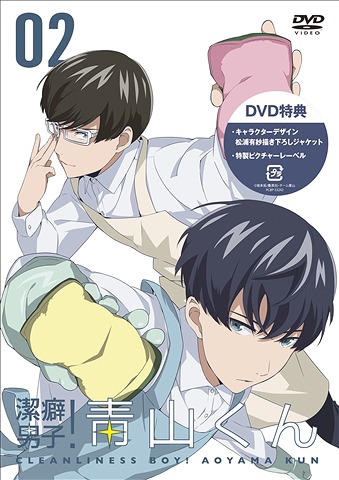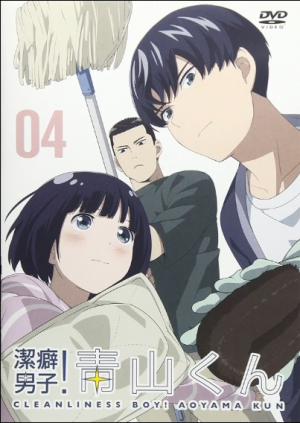Scrub it Away
- Episodes : 12
- Genre : Comedy, Sports, Slice-of-Life
- Airing Date : July 2017 – September 2017
- Studios : Studio Hibari
Contains Spoilers
Keppeki Danshi!! Aoyama-kun Introduction and Story (Spoilers)
Aoyama is about as close to perfection as a high school student could possibly get. He’s handsome, top of his class, and a soccer prodigy to boot. His only problem? Aoyama’s got a nasty case of obsessive compulsive disorder, where he’s barely able to function if he’s even got a speck of dirt on him. But he still loves to play soccer, despite the inherent messiness of the sport, so Aoyama’s made it a point to hold himself back while playing to keep from getting messy. Even with this limitation, Aoyama still manages to play soccer at a higher level than anyone else.
Coach Miwa generally lets Aoyama get away with this self-restriction because the Fujimi High School team isn’t exactly a contender for the championships. She’s willing to take whatever talent she can get. In fact, most of the team is fairly understanding of Aoyama’s demands barring one person: Zaizen Kaoru. Zaizen is not exactly the most talented of players himself, but he still puts in 110% into everything he does. In a game against Oshigami Minami, a high level school attempting to snag Aoyama for themselves, Zaizen refuses to stand down, inspiring Aoyama in the last 5 minutes of the game to go all-out. He can resist his own anxieties for that long with the knowledge that he can immediately run to the shower afterwards.
Keppeki Danshi doesn’t really have any overarching plot outside of occasionally referencing the fact that Fujimi High needs to keep winning games in the tournament to keep Aoyama from moving to more promising schools. Otherwise, Keppeki Danshi takes an episodic approach, with each episode focusing on one of Aoyama’s classmates at Fujimi High and how they interact with Aoyama. We get stories about the one-sided rivalry with fellow clean freak Narita Shion, the secret manga author Ozaki Atsumu who writes Aoyama as the villain of his massively popular series, Aoyama’s maybe/maybe-not girlfriend Odagiri Mio, and so forth. It’s largely meant more as a gag series where the gags come from how all these different people interpret Aoyama.
What we Enjoyed about Keppeki Danshi!! Aoyama-kun
Soccer anime have been done to death. While Keppeki Danshi is not 100% a sports story, approaching the well-worn genre by giving its title character a major handicap provides a unique angle. And, frankly, obsessive compulsive disorder in general is simply not a subject matter that gets a lot of discussion in anime outside of maybe a quick gag or two. It’s a unique angle, and even as a comedy, it does provide a unique hook to the series.
Since the series never sticks to one specific viewpoint, we do actually get a lot of unique perspectives on Aoyama. For example, in episode 4, we find out that Narita ends up in a guild with Aoyama in an online game they both play. Despite Aoyama’s normally cool demeanor IRL, his online personality is actually much goofier and strange, and from Narita’s perspective, Aoyama can only show this side online because his obsessive tendencies in the real world prevent him from opening up to anyone. However, in episode 6, all Ozaki sees of Aoyama is how everyone idolizes him, while Aoyama just shrugs it off without any appreciation, giving him the inspiration for the most popular character in his manga. It highlights how Aoyama’s OCD simultaneously defines and doesn’t define him.
Discussion Time
For every episode that contains some insight on what has shaped Aoyama into the repressed individual he is today, you get stories like episode 9, where Coach Miwa decides she wants to hold a training camp because her favorite sports anime recently had one. Remember: it’s a gag series first and foremost, so while the brief moments of character study are nice, it’s mostly concerned with fitting in silly gags about the team being dumb high school boys having silly adventures with weird characters. The moments of character growth are mainly used as a means of easing the viewer into understanding the seriousness of Aoyama’s condition.
Don’t take that the wrong way: there’s absolutely nothing wrong with writing a comedy series first and foremost. Comedy is often seen as a less noble pursuit than drama, and that’s not a fair assumption. However, the issue with Aoyama is that, being based off a Shounen Jump manga, the comedy tends to skew fairly young. That’s not to say that it’s impossible to write comedy that has cross-generational appeal, but unfortunately, Keppeki Danshi does not really manage this all that well. If you’re a bit older, there might be a gag here and there that gets a chuckle. Most of the humor, however, is going to be the sort of stuff you’ve seen before. It’s largely gags based around pointing out how absurd the situation is and characters overreacting to the situation, and not a lot else.

1. Doesn’t outright justify Aoyama
The aforementioned episode 6 is perhaps the best example of Keppeki Danshi understanding the rather bizarre obsession everyone has with Aoyama. Ozaki tries to use his manga to highlight how toxic Aoyama’s seemingly uncaring personality is actually harmful by making the Blue Wizard (the series’ main villain) just as nasty as possible while using real life examples of Aoyama’s strange behavior. However, people don’t hate the Blue Wizard. In fact, he turns out to be the most popular character in the series, outshining the main character. Blue Wizard only starts to fail once Ozaki consciously tries to make him more likeable, but once he starts writing Blue Wizard as more actively spiteful, the fans start to get even more annoyed, understanding this is just a ploy to reclaim popularity.
What makes this episode work is that, ultimately, the series never outright justifies Aoyama’s behavior. There’s never any moment where Ozaki comes to realize that people heap love onto Aoyama because he’s secretly this wonderful person that’s too shy to be more open with people, or anything like that. What Ozaki ends up realizing at the end is that it’s his own pettiness toward Aoyama that drives the popularity of the manga, and that people genuinely enjoy being made fun of right to their face without realizing the commentary about them.
2. Moments of successful deadpan humor
When Keppeki Danshi doesn’t stop to dwell on the gag it just made, it can be pretty funny. Episode 2’s second story revolves around everyone trying to sniff Aoyama’s towel for some insane reason. It ends in a grand climax where different groups of fans confront each other to snag the towel. The show gives each gang a dramatic introduction with their names almost booming onto the screen. What makes this scene funny, honestly, isn’t even the aesthetic of it, but how one of the “groups” that showed up is a cat that randomly happened to be around but gets the same introduction as anyone else who’s there. It fakes you out with the assumption that the gag is just how over-the-top the situation is and blindsides you with the introduction of the cat.
3. Odagiri Mio
We list Odagiri here mainly because episode 7 is about the series’ only moment of real growth for Aoyama. The gag about Odagiri is that she’s effectively the school’s idol, but doesn’t seem to realize it herself. However, she’s apparently so charming that even Aoyama is enraptured by her, and even allows Odagiri to touch him for entirely unknown reasons, including to himself. It seemed as if Episode 7 was gearing up for some punchline about how Aoyama only allows her to touch him and no one else because of a silly gag about how there’s something about her that’s “cleaner” than other people or something along those lines, but it actually ends with more questions than answers. Odagiri’s presence is the first real positive influence on Aoyama’s life we see.
1. Overuse of characters reverting to Chibi Form
Are you the type of person who hates watching sitcoms that use canned laughter to signify when it’s okay for you to laugh? While this is not entirely the case with Keppeki Danshi, often times, when the characters are making a joke, they’re reverted to a chibi form to make the gag seem more friendly. You may not notice it right away, but trust us, once you notice it, you can’t ignore it. Often times it feels like Keppeki Danshi doesn’t have enough confidence in its own jokes to let them land properly, so it transforms the characters into a chibi form to make the punchline seem like it carries more weight than it actually does.
A great example of this is actually in the very first episode. It’s the middle of a practice match for Fujimi High School, and Zaizen is running with Aoyama in an attempt to one-up him. Zaizen jumps up for the ball, but Aoyama, strangely, stays on the ground. Zaizen, initially confused, quickly realizes Aoyama already stopped because he saw two other players jump into the air, and they all collide. This is a fairly standard gag, but the problem is that, when Aoyama stops, he’s already in chibi form, while Zaizen is still in his “normal mode”. In this case, before we even realized there was going to be a joke, Keppeki Danshi actually signifies with the chibi form that you should get ready to laugh because a joke is coming, ruining the “surprise” of a punchline in the first place.
2. Repetitive Gags
For some reason, Keppeki Danshi is really determined to get you to laugh at the fact that Tsukamoto can bounce a ball on his butt, or that Yoshioka eats a lot because he’s fat. A recurring gag can work when you constantly build on the joke or continue to evolve it in a way that keeps it fresh or unexpected. However, in the case of Keppeki Danshi, the series never takes these gags beyond their surface level interpretation. It’ll have Tsukamoto doing his butt keepy-uppies, or Yoshioka suddenly getting hungry because he sees food, and… that’s the extent of the joke. It just wants you to laugh at the mere suggestion that these are funny situations, and that’s all.
Final Thoughts
Keppeki Danshi is the sort of series that will play well almost exclusively to newer, younger anime fans that are right around junior high or early high school age. It’s a very clean-looking series with attractive, inoffensive character designs and absurdist humor that’s fun for people who are just discovering that type of humor. However, outside of that very specific demographic, it’s very difficult to recommend Keppeki Danshi. Even with the premise, it doesn’t really do much new or interesting with the genre, even with the unique premise.
Disagree? Have some examples of gags to prove us wrong? We’d love to see them in the comments below!
Recommended Post
Keppeki Danshi! Aoyama-kun - Summer 2017 Anime
Recommended Post



